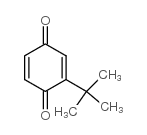叔丁基对苯醌

叔丁基对苯醌结构式

|
常用名 | 叔丁基对苯醌 | 英文名 | 2-tert-Butyl-1,4-benzoquinone |
|---|---|---|---|---|
| CAS号 | 3602-55-9 | 分子量 | 164.20100 | |
| 密度 | 1.092 g/cm3 | 沸点 | 227.8ºC at 760 mmHg | |
| 分子式 | C10H12O2 | 熔点 | 54-58 °C(lit.) | |
| MSDS | 中文版 美版 | 闪点 | 82.6ºC | |
| 符号 |

GHS07 |
信号词 | Warning |
|
Reduction of cytotoxic p-quinone metabolites of tert-butylhydroquinone by human aldo-keto reductase (AKR) 1B10.
Drug Metab. Pharmacokinet. 27(5) , 553-8, (2012) 2-tert-Butylhydroquinone (BHQ), an antioxidant used as a food additive, exhibits an anticancer effect, whereas it is carcinogenic in rodents at high doses. BHQ is metabolized into cytotoxic tert-butylquinone (BQ), which is further converted to 6-tert-butyl-2,... |
|
|
Paradoxical cytotoxicity of tert-butylhydroquinone in vitro: What kills the untreated cells?
Arch. Toxicol. 86(9) , 1481-7, (2012) At high concentrations, tert-butylhydroquinone (tBHQ), a phenolic antioxidant frequently used as a food preservative, exerts cytotoxic effects, which are closely linked to its ability to form reactive oxygen species as a consequence of redox cycling processes... |
|
|
Irreversible inhibition of rat hepatic glutathione S-transferase isoenzymes by a series of structurally related quinones.
Chem. Biol. Interact. 71(4) , 381-92, (1989) The effect of several structurally related 1,4-benzoquinones (BQ) and 1,4-naphthoquinones (NQ) on the activity of rat hepatic glutathione S-transferases (GST) was studied. For the 1,4-benzoquinones, the extent of inhibition increased with an increasing number... |
|
|
Initiating activity of 3-tert-butyl-4-hydroxyanisole (3-BHA) and its metabolites in two-stage transformation of BALB/3T3 cells.
Carcinogenesis 11(11) , 1985-8, (1990) 3-tert-Butyl-4-hydroxyanisole (3-BHA) and its metabolites, tert-butyl-1,4-benzoquinone (BQ) and 3-tert-butyl-5-methoxy-1,2-benzoquinone (BHAoQ), were tested for initiating activity in a two-stage transformation assay using BALB/3T3 cells. Cells were treated f... |
|
|
Formation of the semiquinone anion radical from tert-butylquinone and from tert-butylhydroquinone in rat liver microsomes.
Toxicology 74(2-3) , 127-33, (1992) The tert-butylsemiquinone anion radical is formed from tert-butylhydroquinone and from tert-butylquinone in rat liver microsomes. In the presence of oxygen, the quinone and, less extensively, the hydroquinone induce excess production of superoxide in microsom... |
|
|
Cytotoxic and genotoxic properties of tert.-butyl-p-quinone (TBQ) in an in vitro assay system with Chinese hamster V79 cells and in strain D7 of Saccharomyces cerevisiae.
Mutat. Res. 299(1) , 9-18, (1993) tert.-Butyl-p-quinone (TBQ), a major metabolite of the phenolic antioxidant tert.-butyl-4-hydroxyanisole (BHA), was examined for cytotoxic and genotoxic properties in an in vitro assay system with Chinese hamster V79 cells and in diploid strain D7 of Saccharo... |
|
|
The reaction of butylated hydroxyanisole and its metabolites with some arylamines: investigations of product mutagenicity.
Environ. Health Perspect. 102(1) , 96-9, (1994) We examined t-butylhydroquinone (t-BHQ) and t-butylquinone (t-BuQ), two of the major microsomal metabolites of the synthetic antioxidant butylated hydroxyanisole (BHA), for their ability to react with the xenobiotic arylamines aniline and N-methylaniline. A n... |
|
|
Isolation and characterization of some products of the BHA-nitrite reaction: examination of their mutagenicity.
Food Addit. Contam. 7(2) , 223-33, (1990) The reaction mixture and several products arising from the reaction of butylated hydroxyanisole (BHA) and nitrite in anaerobic aqueous acidic solution were separated and tested in the Salmonella mutagenicity test. Among the nine products separable by thin-lay... |
|
|
Structural identification of extractables from rubber closures used for pre-filled semisolid drug applicator by chromatography, mass spectrometry, and organic synthesis.
J. Pharm. Biomed. Anal. 34(5) , 841-9, (2004) Extractables or leachables from rubber closures used for drug products can potentially be detrimental since some of these rubber extractables are known to be toxic and pyrogenic. In addition, these extractables could interfere with analysis or even affect the... |
|
|
The effect of the tert-butylquinone metabolite of butylated hydroxyanisole on cytochrome P-450 monooxygenase activity.
Xenobiotica 20(9) , 915-24, (1990) 1. The t-butylquinone metabolite of BHA was shown to redox cycle with NADPH-cytochrome P-450 reductase leading to enhanced NADPH-oxidase activity for both the purified and liver microsome-bound flavoprotein. Likewise, addition of t-butylquinone (20-100 microM... |